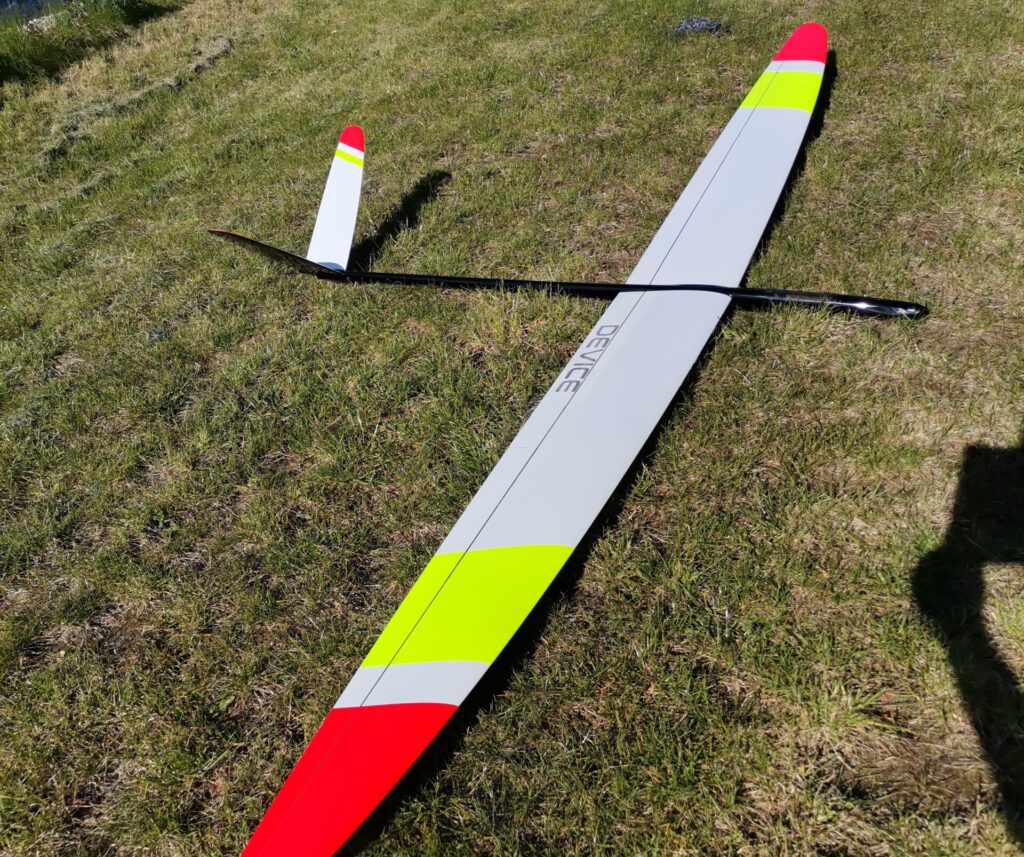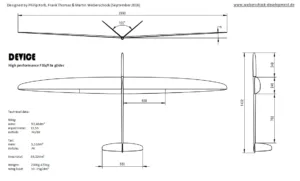Device (glider)
The F3B model ”Device” is an amazing development by Benjamin Rodax and Philip Kolb. The Team Badesalz turns the draft into a special F3B model which masters all requirements. Every component and every detail is developed with experience and the goal to create an optimized plane.
Wings
The wings of the Device are manufactured with “Vladimir carbon”. This is a biaxial carbon which weights as highmodul carbon only 34g/m2. Due to the respective torsional forces that act on the wing, the individual fabric layers are graded. In the middle of the wing, there are up to 4 layers of carbon non-crimp fabric in the outer shell and one layer forms the inner layer in the sandwich. The spars of the wing are glued with the outer layers. Therefore the Device has got a perfect strong structure.
The non-crimp fabric enables a surface without any fabric structure. The successful use of the Device demonstrates the correctness of our uncompromising approach!
The model holds the world best time in speed flight with 11.66 seconds.
All “Device pilots” appreciate the handling of the Device as extremely easy and comfortable.
You can order your wing according to your requirements:
- You choose the servo variant so the wing is delivered with the correct IDS servo linkage for your servos. E.g. KST X 10; KST X 10 Mini, MKS HV 6130, MKS HBL 6625, JR HV 189 or others.
- You can choose your own design.
- The wiring is prepared in the wing
I also offer you to equip the models.

Versions:
- Super-light version: approx. 1000g wing weight, built with highmodul carbon non-crimp fabric. A take-off weight in the glider version of 1800g is possible (depending on the servos). The wing is only partially capable for winch launches! This wing is very well suited to create a light wind high-performance motor glider with the electric fuselage. The wing weight can vary due to the respective design. The lightest one is visible carbon. Light RAL colours weight a lot…
- Light version: approx. 1060g wing weight, built with highmodul carbon non-crimp fabric. The wing is capable to winch launches. The construction of the spar is equal to the F3B and F3F versions. A take-off weight in the glider version of 1900g is possible (depending on the servos).
- Worldcup HM version: approx. 1160g wing weight, built with highmodul carbon non-crimp fabric. 2 layers 34g/m2 over the whole wing and a third layer in the D-box up to the aileron area (reinforcements in the flaps). A take-off weight in the glider version of 2000g is possible (depending on the servos and design).
- High end HM version: approx. 1200g wing weight, built with highmodul carbon non-crimp fabric. 2 layers 34g/m2 over the whole wing and a third layer in the middle wing area. This version is used by Team Badesalz in competitions. A take-off weight in the glider version of 2100g is possible (depending on the servos and design).
- F3F 4 layers HM version: from 1300g wing weight, built with highmodul carbon non-crimp fabric. 3 layers 34g/m2 over the whole wing and a fourth layer in the middle wing area. A take-off weight in the glider version of 2200g is possible (depending on the servos).
- F3F 4 layers IMS version: approx. 1340g wing weight. The shell is made with 3 layers 39g/m2 IMS carbon non-crimp fabric over the entire wing and has got a fourth layer in the middle wing area. Green Airex is used as support material. This wing is constructed to be robust even in difficult landing situations. A take-off weight in the glider version of 2300g is possible (depending on the servos, design and fuselage version).
Fuselage
The fuselages of today’s F3B models are very similar. It depends on the construction. The fuselage of the Device is also built in highmodul carbon non-crimp fabric and different highmodul carbon fibers using inflate process. In critical areas of the fuselage, there are up to 14 layers of fiber material. The front fuselage is made of glassfiber and kevlar. So the antenna can stay under the nose. In the F3B version, the fuselage weights around 200g. In a reinforced F3F version, the fuselage weights 30g to 45g more. The difficult landing conditions for flying on slopes are taken into account here. Our fuselages are counted to the best worldwide and they haven’t got any weak point!

